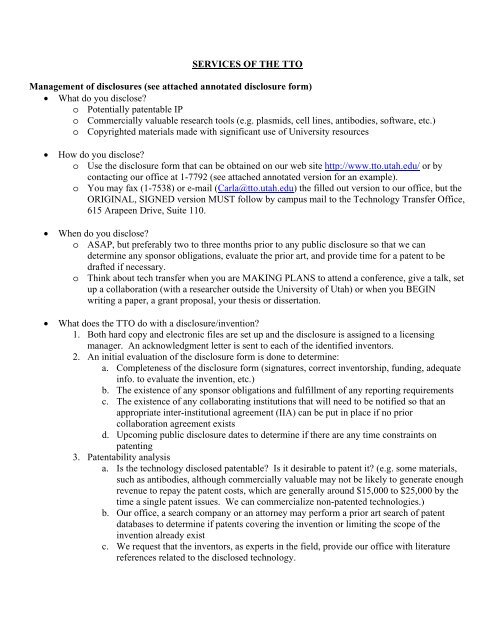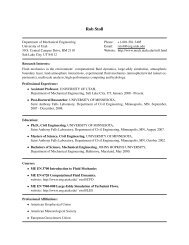University of Utah Technology Transfer Office Handout
University of Utah Technology Transfer Office Handout
University of Utah Technology Transfer Office Handout
You also want an ePaper? Increase the reach of your titles
YUMPU automatically turns print PDFs into web optimized ePapers that Google loves.
SERVICES OF THE TTO<br />
Management <strong>of</strong> disclosures (see attached annotated disclosure form)<br />
• What do you disclose?<br />
o Potentially patentable IP<br />
o Commercially valuable research tools (e.g. plasmids, cell lines, antibodies, s<strong>of</strong>tware, etc.)<br />
o Copyrighted materials made with significant use <strong>of</strong> <strong>University</strong> resources<br />
• How do you disclose?<br />
o Use the disclosure form that can be obtained on our web site http://www.tto.utah.edu/ or by<br />
contacting our <strong>of</strong>fice at 1-7792 (see attached annotated version for an example).<br />
o You may fax (1-7538) or e-mail (Carla@tto.utah.edu) the filled out version to our <strong>of</strong>fice, but the<br />
ORIGINAL, SIGNED version MUST follow by campus mail to the <strong>Technology</strong> <strong>Transfer</strong> <strong>Office</strong>,<br />
615 Arapeen Drive, Suite 110.<br />
• When do you disclose?<br />
o ASAP, but preferably two to three months prior to any public disclosure so that we can<br />
determine any sponsor obligations, evaluate the prior art, and provide time for a patent to be<br />
drafted if necessary.<br />
o Think about tech transfer when you are MAKING PLANS to attend a conference, give a talk, set<br />
up a collaboration (with a researcher outside the <strong>University</strong> <strong>of</strong> <strong>Utah</strong>) or when you BEGIN<br />
writing a paper, a grant proposal, your thesis or dissertation.<br />
• What does the TTO do with a disclosure/invention?<br />
1. Both hard copy and electronic files are set up and the disclosure is assigned to a licensing<br />
manager. An acknowledgment letter is sent to each <strong>of</strong> the identified inventors.<br />
2. An initial evaluation <strong>of</strong> the disclosure form is done to determine:<br />
a. Completeness <strong>of</strong> the disclosure form (signatures, correct inventorship, funding, adequate<br />
info. to evaluate the invention, etc.)<br />
b. The existence <strong>of</strong> any sponsor obligations and fulfillment <strong>of</strong> any reporting requirements<br />
c. The existence <strong>of</strong> any collaborating institutions that will need to be notified so that an<br />
appropriate inter-institutional agreement (IIA) can be put in place if no prior<br />
collaboration agreement exists<br />
d. Upcoming public disclosure dates to determine if there are any time constraints on<br />
patenting<br />
3. Patentability analysis<br />
a. Is the technology disclosed patentable? Is it desirable to patent it? (e.g. some materials,<br />
such as antibodies, although commercially valuable may not be likely to generate enough<br />
revenue to repay the patent costs, which are generally around $15,000 to $25,000 by the<br />
time a single patent issues. We can commercialize non-patented technologies.)<br />
b. Our <strong>of</strong>fice, a search company or an attorney may perform a prior art search <strong>of</strong> patent<br />
databases to determine if patents covering the invention or limiting the scope <strong>of</strong> the<br />
invention already exist<br />
c. We request that the inventors, as experts in the field, provide our <strong>of</strong>fice with literature<br />
references related to the disclosed technology.





